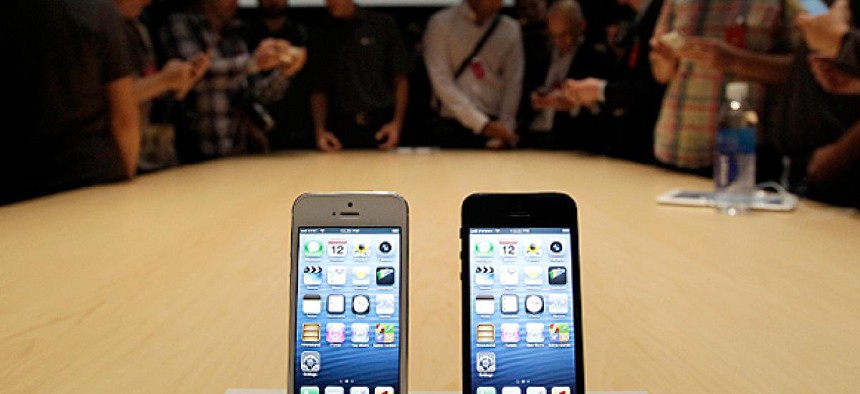iPhone 5? Yawn. What will the 'phone' of 2022 look like?

The new iPhone 5 on display Eric Risberg/AP
A romp through the weird, scary, awesome future of mobile communications.
The near-term future of phones is fairly well-established. The iPhone 5 was released yesterday and its similarity to every Apple phone since 2007 serves as a reminder that our current mobile devices have been sitting on the same plateau for years.
Reflecting on Apple's recent product launches, author and professor at NYU's Interactive Telecommunications Program Clay Shirky told me, "They're selling transformation and shipping incrementalism."
The screens, cameras, and chips have gotten better, the app ecosystems have grown, the network speeds have increased, and the prices have come down slightly. But the fundamental capabilities of these phones hasn't changed much. The way that you interact with phones hasn't changed much either, unless you count the mild success of Siri and other voice command interfaces.
"Is the iPhone 5 the last phone?" Shirky said. "Not the last phone in a literal sense, but this is the apotheosis of this device we would call a phone."
Danny Stillion of the legendary design consultancy IDEO calls our current technological moment the "phone-on-glass paradigm," and it's proven remarkably successful over the last half-decade, essentially conquering the entire smartphone market in the United States and around the world. It seems like this Pax Cupertino could last forever. But if we know a single thing about the mobile phone industry, it's that it has been subject to disruptions.
No one has tracked these market shifts better than Horace Dediu at Asymco. He's documented what he calls "a tale of two disruptions," one from above in Apple and one from below in cheap Chinese and Indian manufacturers. In just the last five years, Nokia, Samsung, LG, and RIM have seen their market shares and profits collapse due to this pincer movement. Our conceit is that change will come again to the smartphone market, and that the phones and market leaders of 2022 will not be the same as they are today.
What might their input methods be? How might the software work? What are we going to call these things that we only occasionally use to make telephone calls?
"It's not clear to me that there is any such device as the phone in 2022. Already, telephony has become a feature and not even a frequently used feature of those things we put in our pockets. Telephony as a purpose built device is going away, as it's been going away for the TV and the radio," Clay Shirky said to me, when I asked him to speculate. "So what are the devices we have in our pockets?"
Read more at The Atlantic.






